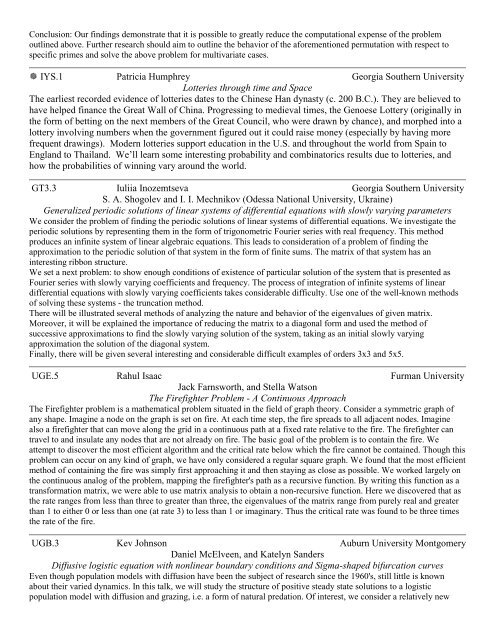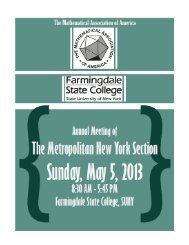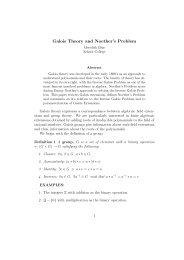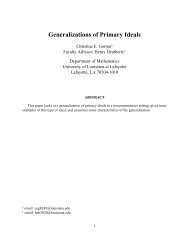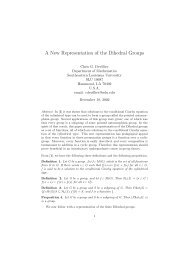Presentation Abstracts - MAA Sections
Presentation Abstracts - MAA Sections
Presentation Abstracts - MAA Sections
Create successful ePaper yourself
Turn your PDF publications into a flip-book with our unique Google optimized e-Paper software.
Conclusion: Our findings demonstrate that it is possible to greatly reduce the computational expense of the problem<br />
outlined above. Further research should aim to outline the behavior of the aforementioned permutation with respect to<br />
specific primes and solve the above problem for multivariate cases.<br />
IYS.1 Patricia Humphrey Georgia Southern University<br />
Lotteries through time and Space<br />
The earliest recorded evidence of lotteries dates to the Chinese Han dynasty (c. 200 B.C.). They are believed to<br />
have helped finance the Great Wall of China. Progressing to medieval times, the Genoese Lottery (originally in<br />
the form of betting on the next members of the Great Council, who were drawn by chance), and morphed into a<br />
lottery involving numbers when the government figured out it could raise money (especially by having more<br />
frequent drawings). Modern lotteries support education in the U.S. and throughout the world from Spain to<br />
England to Thailand. We’ll learn some interesting probability and combinatorics results due to lotteries, and<br />
how the probabilities of winning vary around the world.<br />
GT3.3 Iuliia Inozemtseva Georgia Southern University<br />
S. A. Shogolev and I. I. Mechnikov (Odessa National University, Ukraine)<br />
Generalized periodic solutions of linear systems of differential equations with slowly varying parameters<br />
We consider the problem of finding the periodic solutions of linear systems of differential equations. We investigate the<br />
periodic solutions by representing them in the form of trigonometric Fourier series with real frequency. This method<br />
produces an infinite system of linear algebraic equations. This leads to consideration of a problem of finding the<br />
approximation to the periodic solution of that system in the form of finite sums. The matrix of that system has an<br />
interesting ribbon structure.<br />
We set a next problem: to show enough conditions of existence of particular solution of the system that is presented as<br />
Fourier series with slowly varying coefficients and frequency. The process of integration of infinite systems of linear<br />
differential equations with slowly varying coefficients takes considerable difficulty. Use one of the well-known methods<br />
of solving these systems - the truncation method.<br />
There will be illustrated several methods of analyzing the nature and behavior of the eigenvalues of given matrix.<br />
Moreover, it will be explained the importance of reducing the matrix to a diagonal form and used the method of<br />
successive approximations to find the slowly varying solution of the system, taking as an initial slowly varying<br />
approximation the solution of the diagonal system.<br />
Finally, there will be given several interesting and considerable difficult examples of orders 3x3 and 5x5.<br />
UGE.5 Rahul Isaac Furman University<br />
Jack Farnsworth, and Stella Watson<br />
The Firefighter Problem - A Continuous Approach<br />
The Firefighter problem is a mathematical problem situated in the field of graph theory. Consider a symmetric graph of<br />
any shape. Imagine a node on the graph is set on fire. At each time step, the fire spreads to all adjacent nodes. Imagine<br />
also a firefighter that can move along the grid in a continuous path at a fixed rate relative to the fire. The firefighter can<br />
travel to and insulate any nodes that are not already on fire. The basic goal of the problem is to contain the fire. We<br />
attempt to discover the most efficient algorithm and the critical rate below which the fire cannot be contained. Though this<br />
problem can occur on any kind of graph, we have only considered a regular square graph. We found that the most efficient<br />
method of containing the fire was simply first approaching it and then staying as close as possible. We worked largely on<br />
the continuous analog of the problem, mapping the firefighter's path as a recursive function. By writing this function as a<br />
transformation matrix, we were able to use matrix analysis to obtain a non-recursive function. Here we discovered that as<br />
the rate ranges from less than three to greater than three, the eigenvalues of the matrix range from purely real and greater<br />
than 1 to either 0 or less than one (at rate 3) to less than 1 or imaginary. Thus the critical rate was found to be three times<br />
the rate of the fire.<br />
UGB.3 Kev Johnson Auburn University Montgomery<br />
Daniel McElveen, and Katelyn Sanders<br />
Diffusive logistic equation with nonlinear boundary conditions and Sigma-shaped bifurcation curves<br />
Even though population models with diffusion have been the subject of research since the 1960's, still little is known<br />
about their varied dynamics. In this talk, we will study the structure of positive steady state solutions to a logistic<br />
population model with diffusion and grazing, i.e. a form of natural predation. Of interest, we consider a relatively new


